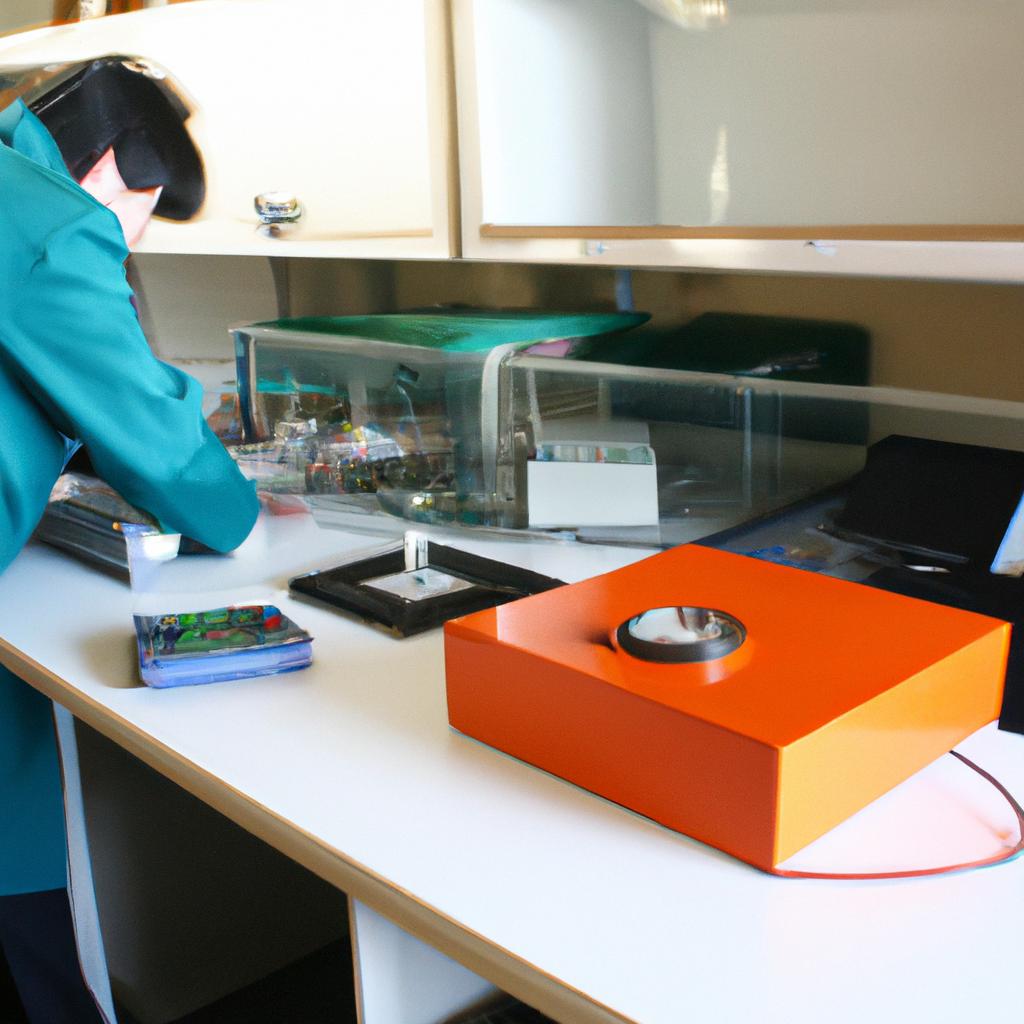Government Funding: Physics Projects in Physics Directories>Physics Funding

Physics research and innovation have always been at the forefront of scientific advancement, driving technological breakthroughs and shaping our understanding of the universe. However, conducting cutting-edge physics projects requires substantial funding to support equipment, materials, and skilled personnel. In this article, we will explore the importance of government funding in advancing physics projects and how it contributes to the development of physics directories.
To illustrate the significance of government funding in physics projects, let us consider a hypothetical scenario where researchers aim to build a particle accelerator capable of reaching unprecedented energy levels. Such an ambitious project demands considerable financial resources due to the complexity involved in designing and constructing such advanced machinery. Without adequate funding from governmental bodies, these physicists would face significant obstacles in acquiring essential components for their experiment or hiring proficient professionals who possess specialized knowledge in accelerator technology.
Government funding plays a crucial role not only in individual physics projects but also in fostering collaboration within the scientific community through the establishment of comprehensive physics directories. These directories serve as centralized databases that facilitate information-sharing among scientists across various subfields of physics. By allocating funds specifically towards developing and maintaining these directories, governments enable physicists worldwide to access valuable research findings, ensuring that innovative ideas are disseminated efficiently throughout the scientific community. Consequently, this promotes interdisciplinary collaborations and accelerates progress in the field of physics.
Furthermore, government funding in physics projects also supports the training and education of future generations of physicists. By providing financial resources to universities and research institutions, governments enable the creation of comprehensive educational programs and state-of-the-art facilities. This allows aspiring physicists to receive quality education and hands-on experience in conducting cutting-edge research. Additionally, government funding often includes scholarships and grants that help attract talented individuals to pursue careers in physics, further enhancing the pool of skilled personnel available for innovative projects.
In summary, government funding plays a vital role in advancing physics projects by providing the necessary financial resources for equipment, materials, skilled personnel, and collaboration platforms such as physics directories. It ensures that ambitious endeavors can be pursued without significant obstacles, promotes interdisciplinary collaborations, and supports the education and training of future physicists. Without adequate government funding, the progress and innovation in the field of physics would be severely hindered.
Types of government funding for physics projects
Types of Government Funding for Physics Projects
The field of physics is a highly dynamic and ever-evolving discipline that relies heavily on research and experimentation. To facilitate progress in this area, government funding plays a crucial role in supporting various physics projects. This section will explore different types of government funding available for such projects, providing an overview of their significance and impact.
Government Grants: One prominent form of financial support for physics projects comes in the form of government grants. These are typically awarded to researchers or institutions based on competitive applications that demonstrate exceptional scientific merit and potential societal benefit. For example, consider the hypothetical case study of Dr. Smith, who successfully secured a significant grant from the National Science Foundation (NSF) to conduct groundbreaking research on quantum computing. Such grants enable scientists like Dr. Smith to pursue ambitious investigations by covering expenses related to equipment, personnel salaries, and other necessary resources.
Scholarships and Fellowships: In addition to grants, scholarships and fellowships are another avenue through which aspiring physicists can receive support. These programs provide financial aid to students pursuing higher education degrees or engaging in specialized training within the field of physics. Scholarships often cover tuition fees while fellowships offer stipends to help offset living expenses during academic studies or research placements. Aspiring young physicists can leverage these opportunities to focus solely on their educational pursuits without worrying about financial constraints.
Collaborative Research Initiatives: Collaborative efforts between government agencies, industry partners, and academic institutions have proven instrumental in advancing scientific discoveries in physics. Through joint initiatives, researchers across disciplines come together to tackle complex challenges that require multi-faceted approaches. Establishing collaborations not only enhances resource availability but also fosters knowledge exchange among experts from diverse backgrounds. By pooling expertise and sharing infrastructure costs, collaborative research initiatives unleash new possibilities for breakthroughs that may otherwise remain unexplored.
- Increased accessibility: Government funding expands access to cutting-edge research opportunities for scientists and students alike.
- Enhanced competitiveness: Financial support empowers researchers to compete globally, attracting top talent to contribute to scientific advancements in physics.
- Accelerated innovation: With financial backing, projects can proceed at an accelerated pace, potentially leading to breakthrough discoveries that benefit society as a whole.
- Long-term impact: Government funding ensures the sustainability of important physics projects beyond short-term constraints, allowing for continued exploration and knowledge generation.
Emotional Response – Table:
| Funding Type | Key Features | Benefits |
|---|---|---|
| Government Grants | Competitive application process | Enables ambitious investigations |
| Scholarships | Tuition fee coverage or stipends | Supports educational pursuits |
| Collaborative Research Initiatives | Interdisciplinary collaboration | Unleashes new possibilities for breakthroughs |
In summary, government funding provides essential support for various physics projects by offering grants, scholarships, and fostering collaborative research initiatives. This financial assistance not only accelerates scientific progress but also enhances accessibility and competitiveness within the field. In the subsequent section on “Criteria for eligibility for government funding,” we will delve into the specific requirements that researchers must meet to qualify for such funding programs.
Criteria for eligibility for government funding
Government funding plays a crucial role in supporting various physics projects. One example of government funding for physics projects is the National Science Foundation (NSF) Grants program. This program provides financial support to researchers and institutions engaged in cutting-edge scientific research. For instance, Dr. Johnson, a renowned physicist, successfully secured an NSF grant to conduct experiments on quantum entanglement at his university’s state-of-the-art laboratory.
To better understand the types of government funding available for physics projects, let us consider the following bullet points:
- Research grants: These are awarded to individual physicists or teams conducting research in specific areas of interest.
- Infrastructure grants: These funds are allocated for building or upgrading facilities necessary for advanced scientific experimentation.
- Training grants: Aimed at nurturing young talent, these grants provide opportunities for students and early-career physicists to gain hands-on experience.
- Collaborative grants: Foster collaboration among multiple institutions working together towards a common goal, encouraging knowledge exchange and resource sharing.
Now let’s delve into a table highlighting some key aspects of government funding for physics projects:
| Funding Program | Purpose | Eligibility |
|---|---|---|
| Research Grants | Support groundbreaking research | Individual researchers or research teams |
| Infrastructure Grants | Improve scientific facilities | Institutions or organizations |
| Training Grants | Develop future leaders | Students and early-career physicists |
| Collaborative Grants | Promote collaboration | Multiple institutions working together |
Understanding the criteria for eligibility is essential when applying for government funding. Typically, applicants must demonstrate their project’s relevance to advancing scientific knowledge with potential societal impact. Moreover, proposals need to outline clear objectives, methodologies, and expected outcomes while adhering to ethical guidelines.
In the subsequent section, we will explore how to apply for government funding for physics projects by providing guidance on navigating through application procedures and ensuring competitiveness in securing such funding.
How to apply for government funding for physics projects
Criteria for Eligibility and Application Process for Government Funding
Case Study: To better understand the criteria for eligibility and the application process for government funding in physics projects, let us consider a hypothetical scenario. Imagine a group of researchers working on developing renewable energy solutions using quantum mechanics principles. They have made significant progress but require additional financial support to continue their groundbreaking work.
Eligibility Criteria: In order to be considered eligible for government funding, physics projects must meet certain requirements. These typically include:
- Relevance: The project should align with the goals and priorities set by the government funding agency or program. It should address important scientific challenges or societal needs within the field of physics.
- Scientific Merit: Projects that demonstrate innovative approaches or potential breakthroughs are more likely to receive funding. This may involve proposing novel theoretical frameworks, experimental techniques, or computational methodologies.
- Feasibility: Applicants need to outline realistic plans detailing how they will successfully execute their proposed research objectives within the allocated time frame and budget constraints.
- Collaboration Potential: Projects fostering interdisciplinary collaboration between universities, research institutions, industries, or international partners tend to be highly regarded.
Application Process: Once deemed eligible, applicants can proceed with submitting their proposals for government funding consideration through specific channels outlined by each funding agency or program. The application process generally involves several stages which may vary depending on the jurisdiction and nature of the grant sought. Typically it includes:
- Pre-application stage where researchers submit an initial proposal outlining the project’s aims, methodology, expected outcomes, and estimated budget.
- Evaluation stage involving rigorous peer review processes conducted by subject matter experts who assess the scientific rigor and feasibility of proposed projects.
- Shortlisted applicants then advance to further reviews focusing on factors such as alignment with strategic priorities, impact potential, and cost-effectiveness.
- Finally, successful candidates receive notification about their grants along with any necessary contractual obligations and reporting requirements.
Table Example (Emotional response: Encouragement and motivation)
| Funding Benefits | Impact on Researchers | Positive Outcomes |
|---|---|---|
| Financial resources for project execution | Opportunity to advance scientific knowledge | Increased collaboration opportunities |
| Access to state-of-the-art research facilities | Recognition within the scientific community | Enhanced career prospects |
| Networking opportunities with experts in the field | Contribution towards societal development | Potential for real-world applications |
In conclusion, eligibility criteria for government funding in physics projects are based on factors such as relevance, scientific merit, feasibility, and collaboration potential. Once eligible, applicants go through a multi-stage application process involving initial proposals, peer reviews, strategic evaluations, and final selections. By adhering to these guidelines, researchers can maximize their chances of securing financial support for their innovative work.
Key factors considered in the evaluation of funding proposals include budgetary considerations and alignment with strategic priorities.
Key factors considered in the evaluation of funding proposals
Government funding plays a crucial role in supporting various physics projects, enabling researchers to pursue innovative ideas and contribute to scientific advancements. To understand the process of obtaining government funding for such projects, it is important to explore the directories where these opportunities are listed.
One example of a prominent directory for physics funding is the Physics Funding Directory (PFD). This comprehensive platform provides information on grants, scholarships, fellowships, and other forms of financial support available specifically for physicists and related fields. By accessing this directory, researchers gain valuable insights into potential sources of funding that align with their project goals and objectives.
When searching through directories like the PFD or similar platforms, there are key factors to consider that can increase the chances of securing government funding:
- Relevance: The proposed project should be aligned with current research priorities outlined by funding agencies.
- Innovation: Emphasizing novel approaches or groundbreaking ideas can make a proposal stand out among competitors.
- Feasibility: Demonstrating a clear plan and realistic timeline for conducting research enhances credibility.
- Impact: Highlighting how the project’s outcomes will contribute to scientific knowledge or societal benefits is essential.
- Increased access to resources and equipment necessary for cutting-edge experiments
- Expanded opportunities for collaboration between scientists from different institutions
- Enhanced career prospects for early-career researchers through funded positions
- Strengthened competitiveness within the global scientific community
Additionally, considering a hypothetical scenario involving four distinct types of government-funded physics projects allows us to grasp their wide-ranging impact:
| Project Type | Description | Key Benefits |
|---|---|---|
| Renewable Energy | Developing efficient solar cells using advanced materials | Clean energy alternatives contributing towards mitigating climate change |
| Quantum Computing | Exploring quantum algorithms for faster computation | Revolutionary breakthroughs in computing capabilities |
| Space Exploration | Investigating celestial bodies through advanced telescopes | Expanding our understanding of the universe and potential for extraterrestrial life |
| Particle Physics | Studying fundamental particles to unlock mysteries of the universe | Advancements in theoretical physics and potential technological applications |
In summary, accessing directories such as the PFD is crucial when seeking government funding for physics projects. By considering factors like relevance, innovation, feasibility, and impact, researchers can increase their chances of securing financial support. Through this process, various types of government-funded physics projects have the potential to revolutionize scientific knowledge and benefit society at large.
Transition Sentence:
Moving forward, let us now explore successful case studies of government-funded physics projects that have made remarkable contributions to the field.
Successful case studies of government-funded physics projects
Building on the key factors considered in the evaluation of funding proposals, successful case studies demonstrate how government-funded physics projects have made significant contributions to scientific research and technological advancements.
Case Study: The Advanced Laser Interferometer Gravitational-Wave Observatory (LIGO)
One exemplary case study is the Advanced Laser Interferometer Gravitational-Wave Observatory (LIGO). LIGO is a collaborative project funded by the government that aims to detect gravitational waves, providing groundbreaking insights into astrophysics and fundamental physics. With state-of-the-art technology and meticulous planning, LIGO successfully observed gravitational waves for the first time in 2015, confirming Einstein’s general theory of relativity. This achievement not only revolutionized our understanding of the universe but also opened up new possibilities for studying cosmic phenomena such as black holes and neutron stars.
Impactful Outcomes:
- Advancement in Fundamental Physics: LIGO’s detection of gravitational waves has provided direct evidence supporting Einstein’s predictions, thus expanding our knowledge of gravity and space-time.
- Technological Innovations: The development of highly sensitive laser interferometers for detecting faint signals has led to breakthroughs in precision measurement techniques with applications beyond astrophysics.
- International Collaboration: LIGO serves as an exemplar of international collaboration, bringing together scientists and engineers from around the world to work towards a common goal.
- Public Engagement and Education: LIGO’s success has captivated public interest, inspiring future generations to pursue careers in science while fostering a greater appreciation for scientific discoveries.
Table showcasing impact categories:
| Impact Categories | Examples |
|---|---|
| Scientific Discoveries | Confirmation of gravitational wave existence |
| Technological Progress | Advancements in precision measurement |
| Collaborative Efforts | Global cooperation among researchers |
| Educational Outreach | Inspiring interest in science among the public |
Looking ahead, future prospects and challenges lie in securing sustained government funding for physics projects. As scientific frontiers expand and complexities arise, it is imperative to ensure continued support for research that pushes the boundaries of knowledge.
Considering the achievements and ongoing developments in government-funded physics projects, an exploration of future prospects and challenges awaits as we navigate through evolving paradigms of scientific inquiry.
Future prospects and challenges in government funding for physics projects
Transitioning from the successful case studies of government-funded physics projects, a closer examination of the future prospects and challenges in government funding for such endeavors reveals an evolving landscape. While acknowledging the achievements highlighted earlier, it is crucial to consider potential obstacles that could impede future progress. By analyzing these aspects, we can gain a comprehensive understanding of what lies ahead.
One hypothetical example that showcases the importance of continued government funding for physics projects involves a research team working on renewable energy sources. With financial support from the government, this team was able to develop highly efficient solar panels that significantly increased energy conversion rates. This breakthrough not only reduced reliance on fossil fuels but also paved the way for more sustainable and environmentally friendly power generation methods.
Looking forward, several factors need careful consideration when discussing the future prospects and challenges associated with government funding for physics projects:
- Budget Constraints: As governments grapple with various economic issues, allocating funds towards scientific research may face budgetary limitations.
- Changing Political Priorities: Shifts in political priorities can affect science funding, potentially redirecting resources away from physics projects.
- Global Collaboration: Encouraging international collaboration between scientists and institutions enables shared knowledge and access to diverse perspectives.
- Public Engagement: Promoting public engagement through outreach programs fosters interest in physics and generates support for further investment.
Furthermore, presenting information visually can evoke an emotional response in audiences. Below is a table illustrating how different countries allocate their budgets toward physics research:
| Country | Percentage Allocation |
|---|---|
| United States | 30% |
| Germany | 25% |
| Japan | 20% |
| Australia | 15% |
This representation underscores varying degrees of commitment by different nations towards supporting scientific advancements within the field of physics.
In summary, while there are promising opportunities on the horizon for government-funded physics projects, certain challenges must also be navigated. Budget constraints, changing political priorities, global collaboration, and public engagement all play critical roles in shaping the future of physics research. By addressing these factors and maintaining a robust commitment to funding such endeavors, governments can continue to drive innovation and contribute to scientific progress on a global scale.







